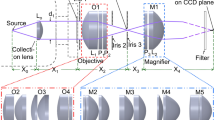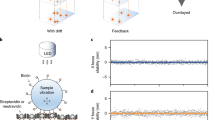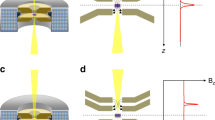Abstract
Optical imaging systems are used extensively in the life and physical sciences because of their ability to non-invasively capture details on the microscopic and nanoscopic scales. Such systems are often limited by source or detector noise, image distortions and human operator misjudgement. Here, we report a general, quantitative method to analyse and correct these errors. We use this method to identify and correct optical aberrations in an imaging system for single atoms and realize an atomic position sensitivity of ∼0.5 nm Hz−1/2 with a minimum uncertainty of 1.7 nm, allowing the direct imaging of atomic motion. This is the highest position sensitivity ever measured for an isolated atom and opens up the possibility of performing out-of-focus three-dimensional particle tracking, imaging of atoms in three-dimensional optical lattices or sensing forces at the yoctonewton (10−24 N) scale.
This is a preview of subscription content, access via your institution
Access options
Subscribe to this journal
Receive 12 print issues and online access
$209.00 per year
only $17.42 per issue
Buy this article
- Purchase on Springer Link
- Instant access to full article PDF
Prices may be subject to local taxes which are calculated during checkout




Similar content being viewed by others
References
Moerner, W. Nobel lecture. Single-molecule spectroscopy, imaging, and photocontrol: foundations for super-resolution microscopy. Rev. Mod. Phys. 87, 1183–1212 (2015).
Betzig, E. Nobel lecture. Single molecules, cells, and super-resolution optics. Rev. Mod. Phys. 87, 1153–1168 (2015).
Eva, R. et al. STED microscopy reveals crystal colour centres. Nature Photon. 3, 144–147 (2009).
Betzig, E. et al. Imaging intracellular fluorescent proteins at nanometer resolution. Science 313, 1642–1645 (2006).
Bakr, W., Gillen, J., Peng, A., Fölling, S. & Greiner, M. A quantum gas microscope for detecting single atoms in a Hubbard-regime optical lattice. Nature 462, 74–77 (2009).
Blatt, R. & Wineland, D. Entangled states of trapped atomic ions. Nature 453, 1008–1015 (2008).
Hell, S. Nobel lecture. Nanoscopy with freely propagating light. Rev. Mod. Phys. 87, 1169–1182 (2015).
Monroe, C. et al. Large-scale modular quantum-computer architecture with atomic memory and photonic interconnects. Phys. Rev. A 89, 022317 (2014).
Eschner, J., Raab, Ch., Schmidt-Kaler, F. & Blatt, R. Light interference from single atoms and their mirror images. Nature 413, 495–498 (2001).
Biercuk, M., Uys, H., Britton, J., VanDevender, A. & Bollinger, J. Ultrasensitive detection of force and displacement using trapped ions. Nature Nanotech. 5, 646–650 (2010).
Schlosser, N., Reymond, G., Protsenko, I. & Grangier, P. Sub-Poissonian loading of single atoms in a microscopic dipole trap. Nature 411, 1024–1027 (2001).
Karpa, L., Bylinskii, A., Gangloff, D., Cetina, M. & Vuletić, V. Suppression of ion transport due to long-lived subwavelength localization by an optical lattice. Phys. Rev. Lett. 111, 163002 (2013).
Schmiegelow, C. et al. Phase-stable free-space optical lattices for trapped ions. Phys. Rev. Lett. 116, 033002 (2016).
Alberti, A. et al. Super-resolution microscopy of single atoms in optical lattices. New J. Phys. 18, 053010 ( 2016).
Noek, R. et al. High speed, high fidelity detection of an atomic hyperfine qubit. Opt. Lett. 38, 4735–4738 (2013).
Burrell, A., Szwer, D., Webster, S. & Lucas, D. Scalable simultaneous multiqubit readout with 99.99% single-shot fidelity. Phys. Rev. A 81, 040302 (2010).
Streed, E., Norton, B., Jechow, A., Weinhold, T. & Kielpinski, D. Imaging of trapped ions with a microfabricated optic for quantum information processing. Phys. Rev. Lett. 106, 010502 (2011).
Shu, G., Chou, C., Kurz, N., Dietrich, M. & Blinov, B. Efficient fluorescence collection and ion imaging with the ‘tack’ ion trap. J. Opt. Soc. Am. B 28, 2865–2870 (2011).
Leibfried, D., Blatt, R., Monroe, C. & Wineland, D. Quantum dynamics of single trapped ions. Rev. Mod. Phys. 75, 281–324 (2003).
Goodman, J. Introduction to Fourier Optics (McGraw-Hill, 1996).
Iglesias, I. Parametric wave-aberration retrieval from point-spread function data by use of a pyramidal recursive algorithm. Appl. Opt. 37, 5427–5430 (1998).
Barakat, R. & Sandler, B. Determination of the wave-front aberration function from measured values of the point-spread function: a two-dimensional phase retrieval problem. J. Opt. Soc. Am. A 9, 1715–1723 (1992).
Avoort, C., Braat, J., Dirksen, P. & Janssen, A. Aberration retrieval from the intensity point-spread function in the focal region using the extended Nijboer–Zernike approach. J. Mod. Opt. 52, 1695–1728 (2005).
Novotny, L. & Hecht, B. Principles of Nano-Optics (Cambridge Univ. Press, 2006).
Speidel, M., Jonáš, A. & Florin, E. Three-dimensional tracking of fluorescent nanoparticles with subnanometer precision by use of off-focus imaging. Opt. Lett. 28, 69–71 (2003).
Nelson, K., Li, X. & Weiss, D. Imaging single atoms in a three-dimensional array. Nature Phys. 3, 556–560 (2007).
Riley, W. Handbook of Frequency Stability Analysis Special Publication 1065 (NIST, 2008).
Barnes, J. & Allan, D. Variances Based on Data with Dead Time Between the Measurements Technical Note 1318 (NIST, 1990).
Thompson, R., Larson, D. & Webb, W. Precise nanometer localization analysis for individual fluorescent probes. Biophys. J. 82, 2775–2783 (2002).
Quan, T., Zeng, S. & Huang, Z. Localization capability and limitation of electron-multiplying charge-coupled, scientific complementary metal-oxide semiconductor, and charge-coupled devices for superresolution imaging. J. Biomed. Opt. 15, 066005 (2010).
Major, F. & Dehmelt, H. Exchange-collision technique for rf spectroscopy of stored ions. Phys. Rev. 170, 91–107 (1968).
Berkeland, D., Miller, J., Bergquist, J., Itano, W. & Wineland, D. Minimization of ion micromotion in a Paul trap. J. Appl. Phys. 83, 5025–5033 (1998).
Keller, J., Partner, H., Burgermeister, T. & Mehlstäubler, T. Precise determination of micromotion for trapped-ion optical clocks. J. Appl. Phys. 118, 104501 (2015).
Anderson, D. Alignment of resonant optical cavities. Appl. Opt. 23, 2944–2949 (1984).
Wyant, J. & Creath, K. Applied Optics and Optical Engineering Vol. XI (Academic, 1992).
Acknowledgements
This work is supported by the US Army Research Office (ARO) with funds from the Intelligence Advanced Research Projects Activity (IARPA) Multi-Qubit Coherent Operations (MQCO) Program and the ARO Atomic and Molecular Physics Program, the Air Force Office of Scientific Research (AFOSR) Multidisciplinary Research Program of the University Research Initiative (MURI) on Quantum Measurement and Verification, the Defense Advanced Research Projects Agency (DARPA) Quiness Program, the Army Research Laboratory Center for Distributed Quantum Information, the National Science Foundation (NSF) Physics Frontier Center at the Joint Quantum Institute (JQI) and the NSF Physics at the Information Frontier Program. The authors also acknowledge support from the Imaging Core at the University of Maryland.
Author information
Authors and Affiliations
Contributions
All authors contributed to the design, construction and carrying out of the experiment, discussed the results and commented on the manuscript. J.D.W.-C. and K.G.J. analysed the data and performed the simulations. J.D.W.-C., K.G.J. and C.M. wrote the manuscript. B.N. and J.M. contributed equally to both the design and construction of the experiment.
Corresponding author
Ethics declarations
Competing interests
The authors declare no competing financial interests.
Supplementary information
Supplementary information
Supplementary information (PDF 437 kb)
Rights and permissions
About this article
Cite this article
Wong-Campos, J., Johnson, K., Neyenhuis, B. et al. High-resolution adaptive imaging of a single atom. Nature Photon 10, 606–610 (2016). https://doi.org/10.1038/nphoton.2016.136
Received:
Accepted:
Published:
Issue Date:
DOI: https://doi.org/10.1038/nphoton.2016.136
This article is cited by
-
Adaptive tip-enhanced nano-spectroscopy
Nature Communications (2021)
-
An easy to construct sub-micron resolution imaging system
Scientific Reports (2020)
-
Wavelength-scale errors in optical localization due to spin–orbit coupling of light
Nature Physics (2019)
-
Ultrafast creation of large Schrödinger cat states of an atom
Nature Communications (2017)
-
Probing nanofriction and Aubry-type signatures in a finite self-organized system
Nature Communications (2017)



